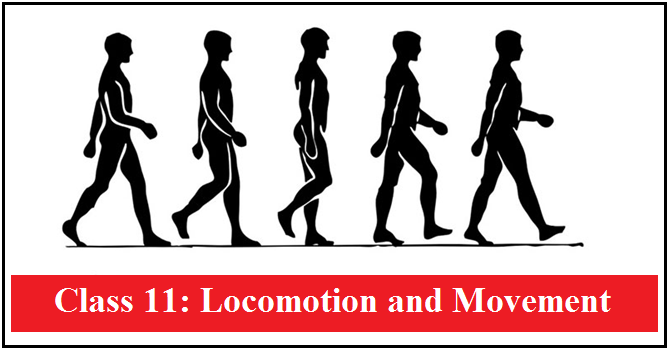MCQ ON LOCOMOTION AND MOVEMENT class 11 for NEET | LOCOMOTION AND MOVEMENT class 11 | MCQ LOCOMOTION AND MOVEMENT with Answer | Check the below NCERT MCQ question for class 11 Biology chapter 20 based on the LOCOMOTION AND MOVEMENT with Answers.

MCQ ON LOCOMOTION AND MOVEMENT class 11
MCQ on LOCOMOTION AND MOVEMENT class 11 Biology with answers were prepared based on the latest pattern.We have provided class 11 Biology MCQs questions on LOCOMOTION AND MOVEMENT with Answers to help students understand the concept very well.
MCQ LOCOMOTION AND MOVEMENT is useful for NEET / CSIR / UGC / CBSE / ICSE / AIIMS / EXAM / AFMC EXAM / STATE LEVEL MEDICAL EXAM 2022-23, 2023-24
Introduction:-
Movement is one of the significant features of living beings.Animals and plants exhibit a wide range of movements.Streaming of protoplasm in the unicellular organisms like Amoeba is a simple form of movement.Movement of cilia , flagella and tentacles are shown by many organisms.Human beings can move limbs,jaws, eyelids, tongue, etc.Some of the movement results in a change of place or location .Such voluntary movements are called locomotion.
MCQ ON LOCOMOTION AND MOVEMENT class 11 for NEET
1.Skeletal muscles are
(a) nonstriated muscles
(b) striated muscles
(c) visceral muscles
(d) all the above
Ans (b) striated muscles
2. The transportation of food through the digestive tract and gametes through the genital tract containing
(a) skeletal muscle
(b) visceral muscles
(c) cardiac muscle
(d) none of the above
Ans. (b) visceral muscles
3. Muscles of heart
(a) skeletal muscle
(b) visceral muscles
(c) cardiac muscle
(d) none of the above
Ans. (c) cardiac muscle
4. The characteristics of cardiac muscle
(a) striated muscles and voluntary in nature
(b) striated muscles and involuntary in nature
(c) nonstriated muscles and involuntary in the Nature
(d) none
Ans.(b) striated muscles and involuntary in nature.
ALSO READ:-
● YOU CAN WATCH BIOLOGY SIR Youtube channel
5. The functional unit of muscles fibres
(a) sarcomeres
(b) sarcolemma
(c) sarcoplasma
(d) none of the above
Ans.(a) sarcomeres
6.True ribs are
(a) First seven pairs of ribs
(b) First 8 pairs of ribs
(c) First 9 pairs of ribs
(d) none of the above
Ans.(a) First seven pairs of ribs
7. False ribs are
(a) first 7 pairs of ribs
(b) 8th ,9th and 10th pairs of ribs
(c) 11th and 12th ribs
(d) none of the above
Ans.(b) 8th , 9th and 10th pairs of ribs
8. The floating ribs are
(a) 11th and 12th pairs of ribs
(b) 8th, 9th and 10th pairs of ribs
(c) first seven pairs of ribs
(d) all the above
Ans.(a) 11th and 12th pairs of ribs
9. Each limb is made of ……bones
(a) 32
(b) 30
(c) 28
(d) 26
Ans. (b) 30 bones
10. Each coxal bone is fusion of
(a) ilium
(b) ischium
(c) pubis
(d) all the above
Ans. (d) all the above
11. Progressive degeneration of skeletal muscle mostly due to genetic disorders
(a) myasthenia gravis
(b) muscular dystrophy
(c) tetany
(d) arthritis
Ans.(b) muscular dystrophy
12. Autoimmune disorders affecting neuromuscular junction leading to fatigue , weakening and paralysis of skeletal muscle.
(a) muscular dystrophy
(b) myasthenia gravis
(c) tetany
(d) arthritis
Ans.(a) myasthenia gravis
13. The inflammation of joints caused
(a) tetany
(b) arthritis
(c) osteoporosis
(d) gout
Ans. (b) arthritis
14. Age related disorders characterised by decreased bone mass and increased chance of fractures.
(a) myasthenia gravis
(b) osteoporosis
(c) gout
(d) arthritis
Ans.(b) osteoporosis
15. Rapid spasm wild contraction in muscle due to low Ca++ in body fluid.
(a) tetany
(b) myasthenia gravis
(c) muscular dystrophy
(d) arthritis
Ans. (a) tetany
16.The joint which donot allow any movement.This type of joint is shown by the flat skull bones .
(a) fibrous joints
(b) cartilaginous joints
(c) synovial joints
(d) all the above
Ans.(a) fibrous joints
17. Saddle joints found in
(a) between atlas and axis
(b) between the carpels
(c) between carpels and metacarpals
(d) between humerus and pectoral
Ans.(c) between carpels and metacarpels
18.Synovial joints are characterized by the presence of a fluid filled synovial cavity between the articulating surface of two bones.Such arrangment allows considerable
(a) movement and locomotion
(b) contraction and relaxation
(c) excitability
(d) Arthritis
And.(a) movement and locomotion
19. The bones help in the articulation of the upper and the lower limbs respectively with the axial skeleton.
(a) pectoral girdle
(b) pelvic girdle
(c) both a and b
(d) none of the above
Ans. (c) both a and b
20. Name the flat bone on the ventral midline of thorax.
(a) pectoral girdle
(b) true ribs
(c) sternum
(d) none of the above
Ans.(c) sternum
21.Repeated activities of the muscles can lead to fatigue due to accumulation of
(a) glucose
(b) lactic acid
(c) mallic acid
(d) citric acid
Ans. (b) lactic acid







Leave a Comment